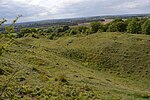Church of St Mary, Eaton Bray
Bedfordshire building and structure stubsChurch of England church buildings in BedfordshireEnglish church stubsGrade I listed churches in BedfordshireUse British English from February 2023

Church of St Mary is a Grade I listed church in Eaton Bray, Bedfordshire, England. It became a listed building on 3 February 1967. The arcades of the nave and the font date from the Early English period. There is a 16th-century communion table. The church was completely reconstructed in the 15th century though the core is 13th-century. The west tower is modern. The arcades of the nave are magnificent; the north arcade is considerably more ornate than the south arcade. The font is of the 13th century. The east window of the south aisle has a central niche and brackets at the sides for sculpted figures.
Excerpt from the Wikipedia article Church of St Mary, Eaton Bray (License: CC BY-SA 3.0, Authors, Images).Church of St Mary, Eaton Bray
Church Lane,
Geographical coordinates (GPS) Address Nearby Places Show on map
Geographical coordinates (GPS)
| Latitude | Longitude |
|---|---|
| N 51.8767 ° | E -0.5925 ° |
Address
Church Lane
LU6 2DJ
England, United Kingdom
Open on Google Maps








